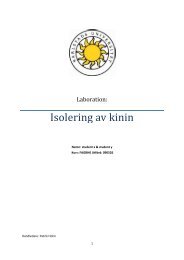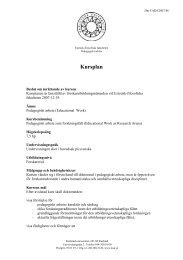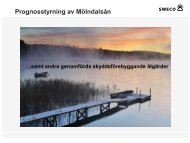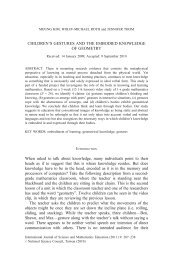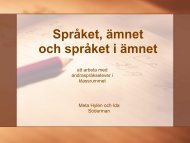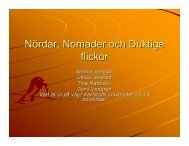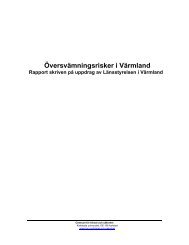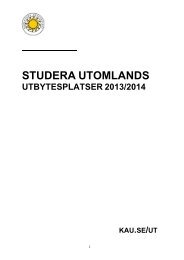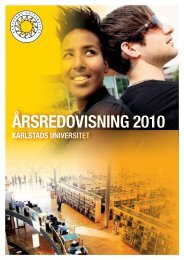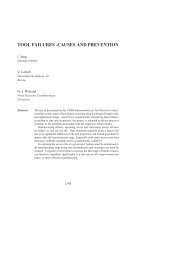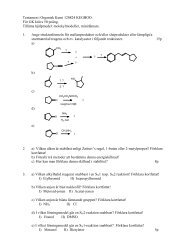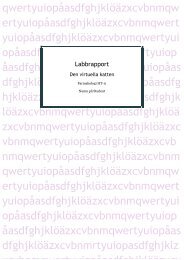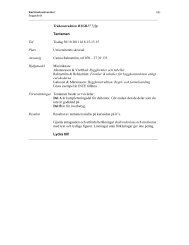Hanna de la Motte
Hanna de la Motte
Hanna de la Motte
Create successful ePaper yourself
Turn your PDF publications into a flip-book with our unique Google optimized e-Paper software.
Karlstad 091118CHEMICALCROSSLINKINGOF SOFTWOOD KRAFT FIBRE NETWORKS TOWARDSAN ABSORPTION PRODUCT<strong>Hanna</strong> <strong>de</strong> <strong>la</strong> <strong>Motte</strong>, Kristoffer Lund, Harald Brelid, Gunnar WestmanChalmers University of TechnologyOrganic Chemistry, Forest Products and Chemical Engineering
<strong>Hanna</strong> <strong>de</strong> <strong>la</strong> <strong>Motte</strong>hanna.<strong>de</strong><strong>la</strong>motte@chalmers.seWooDiThe aim of the research is to invent a moresustainableabsorption structure byimproving the propertiesof the wood-based materials and concurrentlyreduce the <strong>de</strong>pen<strong>de</strong>ncyon non-renewable additives
<strong>Hanna</strong> <strong>de</strong> <strong>la</strong> <strong>Motte</strong>hanna.<strong>de</strong><strong>la</strong>motte@chalmers.seIntroductionPorous network from pulp fibresSuper absorbent polymers (SAP)Decrease the use of nonrenewablematerialsBetter un<strong>de</strong>rstanding of network
<strong>Hanna</strong> <strong>de</strong> <strong>la</strong> <strong>Motte</strong>hanna.<strong>de</strong><strong>la</strong>motte@chalmers.seIntroductionWet stiffness of the fibre network has to be increasedIntra-fibre crosslinking in the fibre walls
<strong>Hanna</strong> <strong>de</strong> <strong>la</strong> <strong>Motte</strong>hanna.<strong>de</strong><strong>la</strong>motte@chalmers.seExperimentalNever-dried bleached Scandinavian softwood kraft pulp supplied by Södra Cell VäroFractionationCrosslinkingPreparation of porous test padsWRV (Water Retention Value)Compression test
<strong>Hanna</strong> <strong>de</strong> <strong>la</strong> <strong>Motte</strong>hanna.<strong>de</strong><strong>la</strong>motte@chalmers.seCrosslinkersThe reactions were performed in acetone, isopropanol or water at for 10-60 min usingdifferent crosslinker concentrations.
Preparation of pads<strong>Hanna</strong> <strong>de</strong> <strong>la</strong> <strong>Motte</strong>hanna.<strong>de</strong><strong>la</strong>motte@chalmers.se
WRV (g/g)<strong>Hanna</strong> <strong>de</strong> <strong>la</strong> <strong>Motte</strong>hanna.<strong>de</strong><strong>la</strong>motte@chalmers.seWRVResults1.0510.950.90.850.80.750.70.650.6Reference(withactivation)Reference(noactivation)(S) withactivation(S) noactivation(L) withactivation(L) noactivation•Sodium hydroxi<strong>de</strong> activates the hydroxy groups, while uncatalysed reaction occursat carboxy<strong>la</strong>te groups belonging to hemicelluloses.• The crosslinked fibres have a substantially lower WRV than the reference fibres.
WRV (g/g)<strong>Hanna</strong> <strong>de</strong> <strong>la</strong> <strong>Motte</strong>hanna.<strong>de</strong><strong>la</strong>motte@chalmers.seWRVResults0.90.80.70.60.50.40.30.20.10Cationic(L) Neutral• The cationic crosslinker showed a higher WRV compared to the non-cationiccrosslinkers.
Wet bulk (cm³/g)<strong>Hanna</strong> <strong>de</strong> <strong>la</strong> <strong>Motte</strong>hanna.<strong>de</strong><strong>la</strong>motte@chalmers.seWet bulk, 15 kPaResults8.007.50y = -6,6211x + 10,729R² = 0,87177.006.50Crosslinker (L)6.005.505.000.5 0.55 0.6 0.65 0.7 0.75 0.8 0.85 0.9WRV (g/g)• Only minor differences between the pads in the dry bulk test, strong hydrogen bonds.• The wet bulk follows the trend of the WRV, a high wet bulk gives a low WRV.• Crosslinking increases the stiffness of the network.
Structure recovery (cm³/g)<strong>Hanna</strong> <strong>de</strong> <strong>la</strong> <strong>Motte</strong>hanna.<strong>de</strong><strong>la</strong>motte@chalmers.seStructure recoveryResults181614121086420Reference(withactivation)Reference(noactivation)(S) withactivation(S) noactivation(L) withactivation(L) noactivation•Crosslinked pads regain most of their initial structure.• Indicates that an increase in crosslinking in the fibre wall give more stable fibrils.• The data corre<strong>la</strong>tes well with the WRV and wet bulk.
Time (min)Time (min)<strong>Hanna</strong> <strong>de</strong> <strong>la</strong> <strong>Motte</strong>hanna.<strong>de</strong><strong>la</strong>motte@chalmers.seMultivarate analysisResultsWet bulkStructure recoveryTemperatureTemperature• Longer reaction times are favourable as well as acetone as solvent.• A longer reaction time does not require the highest temperature for an improvedstructure recovery.
<strong>Hanna</strong> <strong>de</strong> <strong>la</strong> <strong>Motte</strong>hanna.<strong>de</strong><strong>la</strong>motte@chalmers.seConclusionThe new crosslinking method increases the wet bulkand the structure recoveryAn evi<strong>de</strong>nt corre<strong>la</strong>tion between the wet bulk and thewater retention value (WRV) can be seenLonger reaction times are favourable to improve thestructure recovery of the fibre network
<strong>Hanna</strong> <strong>de</strong> <strong>la</strong> <strong>Motte</strong>hanna.<strong>de</strong><strong>la</strong>motte@chalmers.seFuture workThe results presented are the outcome of initial effortsin a <strong>la</strong>rger research projectThe future requires more fundamental knowledgeabout the influence of chemical modifications towardsspecific fibre network propertiesImprovement of analytical methods on a molecu<strong>la</strong>rscale
Acknowledgements<strong>Hanna</strong> <strong>de</strong> <strong>la</strong> <strong>Motte</strong>hanna.<strong>de</strong><strong>la</strong>motte@chalmers.se
Thank you!<strong>Hanna</strong> <strong>de</strong> <strong>la</strong> <strong>Motte</strong>Chalmers University of Technologyhanna.<strong>de</strong><strong>la</strong>motte@chalmers.se



